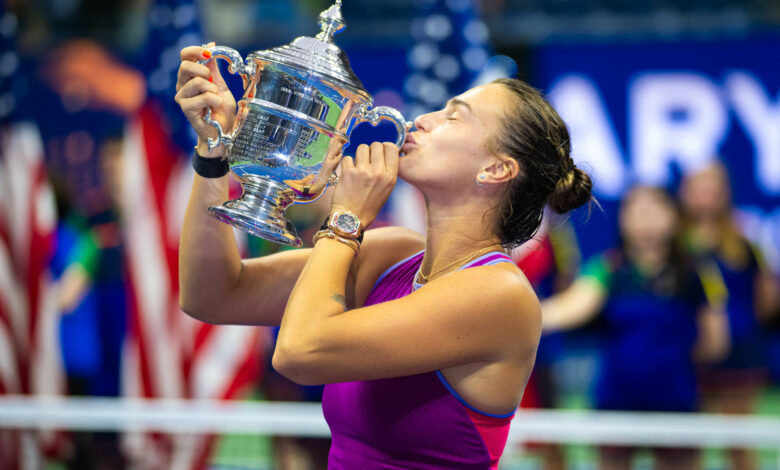Aryna Sabalenka’s US Open victory confirms battle for supremacy with Iga Swiatek

NEW YORK — By winning the US Open, Aryna Sabalenka established herself as the leading force in women’s tennis today — but world No. 1 Iga Swiatek will have something to say about that.
Sabalenka’s gritty 7-5, 7-5 victory over Jessica Pegula felt like a milestone for a number of reasons. It’s Sabalenka’s first Grand Slam outside of the Australian Open, and it makes her the only WTA player currently with two majors. Most importantly, it shows a clear improvement from a year ago.
Last September, Sabalenka faded in the Arthur Ashe Stadium final against Coco Gauff. She won the first set, but then imploded and lost quite comfortably in three sets. Something similar happened against Swiatek in the semifinals in 2022, when the Pole won the tournament.
History looked set to repeat itself against another American on Saturday as Sabalenka dropped five straight games to trail 5-3 in the second set.
Instead, she won four games in a row and dragged herself over the finish line, drawing on the variation she had developed over the past year, which also helped her win the first set with a drop shot and a clinical volley.
With improvements in her game and mental strength, Sabalenka is on the rise, also achieving complete dominance on hard courts in the biggest events. In her last 28 Grand Slam matches on the surface, she has won 27.

Aryna Sabalenka has become the dominant force in hardcourt tennis this year. (Charly Triballeau/AFP via Getty Images)
Swiatek, like Sabalenka, can be considered a clay court specialist. She has won four of the last five French Opens, and all of the last three. Before winning this year’s title, she won the leading WTA 1000 tournaments in Madrid and Rome, beating Sabalenka in both finals.
She ended the 2024 clay-court swing with a record of 22 wins and one loss, against Elena Rybakina in Stuttgart. Swiatek and Sabalenka are undeniably at the top of the women’s game as the season enters its final stretch, and the stage is set for a hard-court vs. clay-court battle for supremacy.
Or maybe not. Swiatek won Doha in February, Indian Wells in March and won the WTA Finals title late last year. She has an 88 percent winning percentage in 2024, won the 2022 US Open by beating Sabalenka en route and has 16 titles at Grand Slam, WTA 1000 and Tour Finals level, compared to Sabalenka’s nine, with the Belarusian three years older.
Sabalenka reached the French Open quarterfinals with ease, losing to Mirra Andreeva in three sets while ill; the Belarusian was also forced to withdraw from Wimbledon with a shoulder injury. This is not a story of superficial tension, but rather a battle between Grand Slam dominance and remarkable consistency.
Swiatek exited in the third rounds of the Australian Open and Wimbledon, before losing in the quarterfinals to Jessica Pegula here. She has not advanced beyond the last eight at a Grand Slam other than the French Open since winning there in 2022, while Sabalenka has reached the semifinals or better in seven of her last eight majors.
Swiatek remains the deserved world No. 1, by a margin of more than 2,100 points, even after Sabalenka’s victory. But someone else is now winning on the biggest stages with the consistency that many expect from Swiatek, and given the variety in their schedules this year, Sabalenka’s trajectory could continue more easily than Swiatek could accelerate her own already remarkable rise.

Swiatek is also a US Open champion, winning the title in 2022. (Kena Betancur/AFP via Getty Images)
In preparation for the US Open, Sabalenka spoke about how much the rest during Wimbledon and the Olympics had helped her. She said that in hindsight, she should have taken a break in March, following the death of her ex-boyfriend Konstantin Koltsov, a former Belarusian ice hockey international.
“I only realised it after I got injured and had to take a step back, that it (a break) was really necessary,” she said at a post-tournament press conference.
Throughout the tournament, Sabalenka has a lightness that comes from winning match after match. She now has a streak of 12 straight in which she has lost a single set. On Saturday night, she joked at her press conference, laughing about the temporary tiger tattoo on her coach Jason Stacy’s head and self-deprecatingly saying that she might try serve-volleying if she had the guts.
“A Plan C,” she called it, which is a terrifying proposition. It was evidence of how full of potential Sabalenka feels — winning does that to a player. She goes into the Australian Open in January as a heavy favorite and thinks the whole world No. 1 thing will sort itself out.
“I try not to focus on the rankings, to be honest,” Sabalenka said Saturday, sounding like the tennis equivalent of the carefree millionaire who says he’s not really motivated by money.
“It’s not like I’m going to see where I’ll be after the tournament. I know that if I can play my best tennis in every tournament, I can become the world number 1 again.”
Swiatek, on the other hand, said this summer that the increase in the number of mandatory events on the WTA Tour schedule is too demanding for players.
After being defeated by Pegula on Wednesday, she was told she might benefit from a break.
“I don’t think it makes sense,” said Swiatek, who also delivered a great performance at the Olympics, winning a bronze medal.
“Once you’re out of the tour, it’s pretty hard to come back. I don’t want to take a break.”

Iga Swiatek was frustrated by her shock semi-final loss to Zheng Qinwen at the 2024 Paris Olympics. (Dimitar Dilkoff/AFP via Getty Images)
Sabalenka’s success may suggest a comeback is possible, but the coming months will unfold and it’s also a reminder that Grand Slam results aren’t everything in the rankings, with Swiatek so far ahead. In 2023, Sabalenka ironically became world No. 1 after losing to Gauff at the US Open, before Swiatek bounced back at the WTA Finals.
Overall, it’s been a year in which the top of the women’s game has settled down a bit. It’s the first season since 2014 that there hasn’t been a first-time champion at the majors — although Barbora Krejcikova’s Wimbledon victory was a surprise.
Swiatek remains comfortably at the top, with the most titles (five), the most WTA 1000 titles (four) and the most matches won (59). She also has the highest winning percentage, at 88. By all conceivable measures, she is the best player in the world. But Sabalenka is the one with the tangible Grand Slam titles and the intangible momentum, heading into 2025 to defend her double Australian Open title without having to overcome any major problems on the court.
Despite it being a phenomenal year statistically for Swiatek, she can’t say that. Her losses follow a pattern where she can’t deviate from Plan A to Plan B. That’s a skill Sabalenka used to win the semifinals and final here in New York.
Sabalenka is not the best player in the world on paper. But she would not want to trade her position with anyone else at this moment.
(Top photo: Robert Prange/Getty Images)




